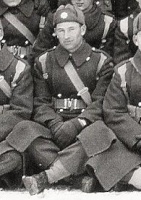I'm a little confused about this, hope someone can help. I was wondering if a badge was issued or conceived to wear for the fitter trade...or would this be the same as the artificer badge? I am putting together a battledress blouse for a shadowbox display and want to get it right. The veteran in question qualified as a driver mechanic, mechanic MV(motor vehicle), and later on, fitter MV.
2 posters
Skill at Arm Badge - Fitter

mk1rceme- Administrator
- Posts : 2215
Join date : 2009-11-22
Age : 53
Location : Alberta, Canada
- Post n°1
 Skill at Arm Badge - Fitter
Skill at Arm Badge - Fitter
_________________
Dale
Admin-CMCF

Bill- Moderator
- Posts : 1120
Join date : 2009-11-28
- Post n°2
 Re: Skill at Arm Badge - Fitter
Re: Skill at Arm Badge - Fitter
Hi Dale, There are many answers to your question. Several factors determine the correct one. First, the date has to be determined. Eg, when did he qualify? And where did he serve? And, most importantly, did he follow the rules?
The Driver/Mechanic was represented by a four spoke wheel, and the Fitter MV and Mechanic Motor Vehicle was represented by the hammer and tongs until 1942. Officially. (If I am reading the reference correctly.) Then the "T" badges were introduced, with three different grades: plain "T", "T" over laurel spray, and "T" with laurel spray and king's crown. Depending on the date and rank, one of these would be correct. But only if in Canada. (The rule to remove trade badges overseas was often ignored, and a wide range of British trade badges were also acquired and worn. Without authorization.)
Maybe the best is to ask the vet when he qualified and where he served to determine the correct patches. Even then, a lot of fellows simply ignored the regulations and wore what they believed to be the badge to which they were entitled.
Post 1956 the entire scheme changed again.
The Driver/Mechanic was represented by a four spoke wheel, and the Fitter MV and Mechanic Motor Vehicle was represented by the hammer and tongs until 1942. Officially. (If I am reading the reference correctly.) Then the "T" badges were introduced, with three different grades: plain "T", "T" over laurel spray, and "T" with laurel spray and king's crown. Depending on the date and rank, one of these would be correct. But only if in Canada. (The rule to remove trade badges overseas was often ignored, and a wide range of British trade badges were also acquired and worn. Without authorization.)
Maybe the best is to ask the vet when he qualified and where he served to determine the correct patches. Even then, a lot of fellows simply ignored the regulations and wore what they believed to be the badge to which they were entitled.
Post 1956 the entire scheme changed again.
|
|
|

